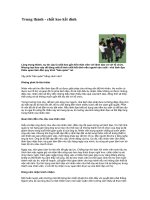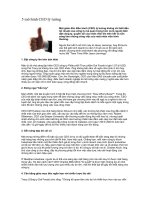Tài liệu Three-on-one''''s" vs. Three "One-on-one''''s" pdf
Bạn đang xem bản rút gọn của tài liệu. Xem và tải ngay bản đầy đủ của tài liệu tại đây (35.75 KB, 4 trang )
October 7, 1997
(Updated May 3, 2000)
FILE MEMORANDUM
Subject: Comprehensive Interviews via "Three-on-one's" vs. Three "One-on-one's"
This evaluates the relative strengths of these two approaches to day visit comprehensive interviewing and sets
forth some important requirements to successfully implement Three-on-one interviews. Both of these
approaches have been used in management selection. Although three separate One-on-one interviews is used
predominately, U.S. Customer Business Development switched to Three-on-one's for all day visits in 1994/95,
and U.S. Human Resources has been using Three-on-one's regularly. Global Recruiting has experience with
both approaches in selecting its own staff, and some U.S. Product Supply recruiters have had experience with
both approaches.
Three-on-one interviews typically require about 1.5 hours with a candidate. One-on-one's each require about an
hour. Therefore, interviewers spend more time doing Three-on-one's, while candidates spend less.
Assessment
Properly executed Three-on-one interviews can provide several benefits compared to a series of three One-on-
one's.
1. Candidates spend less time under interrogation and do not have to repeat the same information on separate
occasions.
2. Potentially more time is available during the day for candidate selling activities.
3. Administratively, it is easier to consistently meet the objective of giving an offer before the day visit
concludes.
4. Each decision maker may be exposed to more assessment information in the Three-on-one versus what they
would likely have covered in their shorter One-on-one.
5. The Three-on-one situation probably helps motivate each interviewer to do their job well.
6. The Three-on-one situation provides an opportunity for less experienced or less skilled interviewers to learn
from the others.
7. The obtained information may be more completely and accurately recorded by those listening, while others
are asking questions.
There are also potential risks with Three-on-one interviews.
1. Candidates may be more anxious, particularly if they have never done it before .
2. There may be a subtle "group think" dynamic in which interviewers of lower rank are less willing to
disagree, since they all heard the same information.
3. Some degree of diversity in the information probed may be lost.
Training and Preparation for Three-on-one's
A Three-on-one only happens once for the candidate, so there is a greater risk that poor execution could
dramatically affect decisions (by P&G and by the offered candidates). Excellence in execution can largely
nullify the risks inherent in Three-on-one's. But, there is clearly a need for quality training and management of
interviewers to achieve it. Just having three interviewers show up together won't do it.
Comprehensive Interviews: "Three-on-one's" vs. "One-on-one's"
Page 2
Intranet/Panel Interview CBA.doc
A coaching tool for Three-on-one interviews is attached. It is based on U.S. CBD's training and covers:
1. How interviewers should prepare (including a pre-interview meeting).
2. How to divide the responsibilities among the interviewers while maintaining a sensible sequence of topics.
3. What interviewers must do post-interview, prior to meeting for a decision.
4. How information will be shared and decisions reached in the meeting.
We also strongly encourage every interviewer (in either Three-on-one's or One-on-one's) to attend a Total
Assessment Interviewing course (classroom or CD-ROM version) as a requirement for interviewing. We should
not have an untrained interviewer in Three-on-one's just because the other interviewers are experienced.
Armed with this, and alerted to the risks inherent in Three-on-one's, many recruiting organizations may be
capable of providing the interviewer training and administrative support required to effectively use the Three-
on-one approach.
J. C. Callender
Attachment
IMPLEMENTING THREE-ON-ONE COMPREHENSIVE INTERVIEWS
PRE-INTERVIEW
All three interviewers meet to review the candidate's file and agree to an interview process. This includes
deciding who will have the leader role, and who will have the roles of interviewer 2 and 3.
INTERVIEW
All interviewers record notes on an Interview Assessment Form during the interview.
Lead Interviewer
−
Welcome
−
Introductions
−
"Small talk"
−
Purpose
−
Explains how interview will work (e.g., interviewers will rotate asking questions; can address each
answer to the person who asked the question)
−
Starts - asks questions concerning any areas on resume or C.V. which are not clear
−
Asks other interviewers if he/she has questions
−
Ask about career objectives -- why this Function? why P&G?
−
Asks questions concerning skill area # 1 (Leadership), and # 2 (Solutions)
−
Asks other interviewers if they have any additional questions concerning these areas
−
Turns over interview to 2nd Interviewer
2nd Interviewer
−
Asks questions concerning skill area # 3 (Innovation) and # 4 (Risk-Taking)
−
Asks other interviewers if they have any additional questions concerning these areas
−
Turns over interview to 3rd Interviewer
3rd Interviewer
−
Asks questions concerning skill area # 5 (Collaboration) and # 6 (Capacity)
−
Asks other interviewers if they have any additional questions concerning these areas
−
Turns back interview to Lead Interviewer
Lead Interviewer
−
Asks questions concerning skill area # 7 (Mastery - if applicable)
−
Asks other interviewers if they have any additional questions concerning this area
−
Closes - tells candidate this concludes the questions; asks candidate if he/she would like to add
anything that may not have been brought up before; asks if candidate has any questions (Note:
questions should be answered by any interviewer as appropriate).
−
Outlines next steps for candidate
−
Thanks applicant for interviewing, for interest in our Company, and any other appropriate remarks
based on the interview
−
Escorts candidate to next event on schedule
POST INTERVIEW EVALUATION
Each interviewer individually completes the Interview Assessment form, computes the RQ score and band, and
records their recommendation regarding the offer decision before discussing the candidate with other
interviewers.
Intranet/Panel Interview CBA.doc
OFFER DECISION MEETING
(These guidelines are equally applicable to the meeting following three One-on-one's.)
1. Lead Interviewer convenes meeting of all interviewers and makes sure a Rating Guide is available.
2. All interviewers share the conclusion of their interview (beginning with the junior member when job
levels are mixed). They only say "Yes" if they want to offer the candidate, "No" if they don't want to
offer the candidate. No additional explanation is given. At this stage, no intermediate responses are
allowed (Yes, but...).
3. If all interviewers say "Yes," every interviewer still should share any concerns. In most cases this will be
SAW factors where the candidate scored only "Moderate."
4. If all interviewers say "No" (which is very unlikely if the screening has been done properly), each
interviewer quickly summarizes his/her point of view on the candidate, just to clarify/calibrate.
5. When there are mixed votes, proceed as follows:
a. All interviewers focus on demonstrated behaviors in the SAW areas in question.
b. The "No" voters list the SAW where they have given a "Weak" or "Moderate." No additional
explanation is given until everyone has shared their areas of concern.
c. If there are SAW factors where the "No" voters agree upon, they explain their concerns for those
SAWs, and refer to the Rating Guide to help calibrate.
An example:
−
The 2 "No" voters are interviewers 1 and 3.
−
Interviewer 1 gives "Moderate" on Leadership and "Weak" on Collaboration.
−
Interviewer 3 gives "Moderate" on Leadership, "Moderate" on Collaboration and "Moderate" on
Risk-Taking.
−
They first explain their concerns about Collaboration, then about Leadership and then about Risk-
Taking.
−
When the "No" voters have explained their concerns, the "Yes" voters explain why they had a
higher score, if they indeed had a higher score. This is done SAW per SAW.
−
If after full discussion there still is at least 1 "No" vote, the candidate should not be offered.
An example building on the above:
−
Interviewer 2 is also "Moderate" on Leadership, so not much discussion is needed on this SAW.
She is however "Very Strong" on Collaboration and Risk-Taking. She explains the evidence she
heard on those 2 SAWs.
−
No offer should be issued unless the "No" voters can be convinced of the contrary and unless there
is at least one strong advocate of the candidate.
What if ...
•
All interviewers are "Yes, but not enthusiastic"?
Do not offer the candidate. At least one interviewer should be convinced the candidate can succeed at
P&G. We are looking for top people, not for average people.
•
All interviewers think highly of the candidate, but he/she is really more interested in another
department/function?
Refer the candidate to the department that would be more appropriate. Do this only if the interviewers
really think highly of the candidate and have good reasons to believe the candidate would succeed there.









